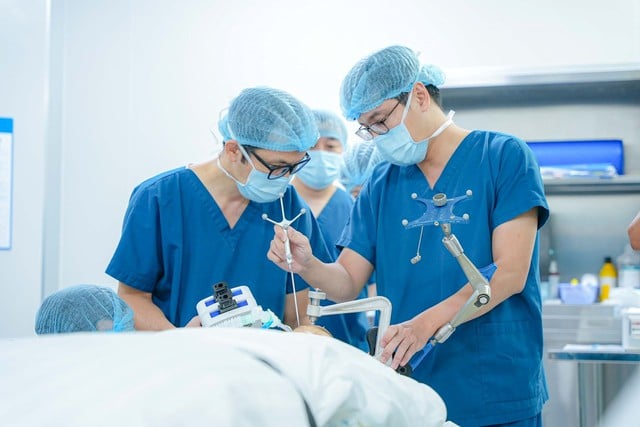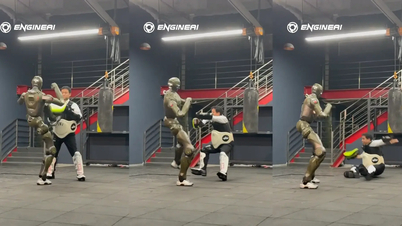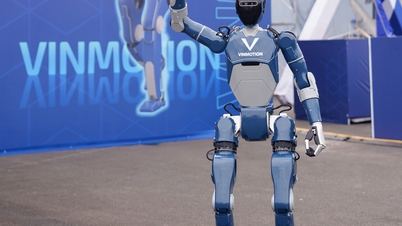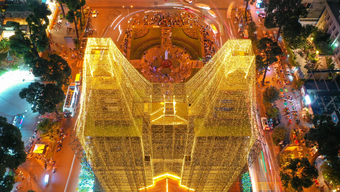Medication treatment is ineffective due to refractory epilepsy.
Nine-year-old BQK, from Hanoi , who suffered from drug-resistant epilepsy, has been successfully treated with robotic-guided surgery at Vinmec Central Park Hospital (Ho Chi Minh City).
Previously, in 2021, K. experienced unusual seizures and was treated with epilepsy medication as prescribed by her doctor. In 2024, despite increased dosage and a combination of medications, the child continued to have frequent seizures, sometimes dozens of times a day. These prolonged seizures severely affected her physical and intellectual development. Despite treatment in many places both domestically and internationally, her condition did not improve.

The medical team installs the Autoguide robotic arm before proceeding to insert electrodes into the skull.
PHOTO: THANH TUYEN
The family brought the child to Vinmec Central Park Hospital for examination. There, after a thorough examination, multidisciplinary consultation, and comprehensive assessment, the doctors decided to apply the technique of intracranial electrode placement under the guidance of the Autoguide robot.
According to Vinmec Central Park Hospital, K.'s case is complex. Current techniques such as scalp electroencephalogram (EEG), magnetic resonance imaging (MRI), and PET scans failed to detect a clear epileptic focus. The patient had used the maximum dose of medication but the condition could not be controlled.
To accurately pinpoint the epileptic focus, doctors need to implant electrodes deep into the brain and continuously record intracranial electroencephalograms (SEEG) over several days (the data helps pinpoint the epileptic focus located deep within the right frontoorbital region and lower frontal lobe, where many nerves and large blood vessels, such as those of the visual and olfactory systems, are concentrated). This is a highly specialized technique requiring near-absolute precision to avoid damaging important nerve and blood vessel structures.
During surgery, the Autoguide robot acts as an intelligent guidance system, helping doctors locate and deliver electrodes to the brain accurately and quickly, minimizing invasiveness. The robotic arm is pre-programmed, ensuring the electrodes reach the correct location for examination without affecting functional areas.
The incision is only a few millimeters, reducing pain, minimizing the risk of infection, and shortening surgical time. Previously, electrode placement relied primarily on skill and experience. With Autoguide, surgery achieves maximum precision in complex cases.
Thanks to precise robotic positioning, the surgery is safe, blood loss is minimized, the intervention time is short, and there are no neurological sequelae.
To date, more than a month after surgery, the child, BQK, is recovering well with no neurological deficits. Only two mild seizures have been recorded during sleep, compared to dozens per day before the surgery.
Vinmec Central Park is currently one of the few medical facilities in Vietnam that possesses the Autoguide robotic navigation system.
Source: https://thanhnien.vn/cong-nghe-robot-dinh-vi-autoguide-dieu-tri-dong-kinh-khang-tri-185250725153610086.htm



![[Photo] Prime Minister Pham Minh Chinh receives Lao Minister of Education and Sports Thongsalith Mangnormek](/_next/image?url=https%3A%2F%2Fvphoto.vietnam.vn%2Fthumb%2F1200x675%2Fvietnam%2Fresource%2FIMAGE%2F2025%2F12%2F16%2F1765876834721_dsc-7519-jpg.webp&w=3840&q=75)
![[Image] The tenacious fighting spirit of Vietnamese women's football](/_next/image?url=https%3A%2F%2Fvphoto.vietnam.vn%2Fthumb%2F1200x675%2Fvietnam%2Fresource%2FIMAGE%2F2025%2F12%2F17%2F1765990260956_ndo_br_4224760955870434771-copy-jpg.webp&w=3840&q=75)
![[Photo] Prime Minister Pham Minh Chinh receives the Governor of Tochigi Province (Japan)](/_next/image?url=https%3A%2F%2Fvphoto.vietnam.vn%2Fthumb%2F1200x675%2Fvietnam%2Fresource%2FIMAGE%2F2025%2F12%2F16%2F1765892133176_dsc-8082-6425-jpg.webp&w=3840&q=75)
![[Live] 2025 Community Action Awards Gala](/_next/image?url=https%3A%2F%2Fvphoto.vietnam.vn%2Fthumb%2F1200x675%2Fvietnam%2Fresource%2FIMAGE%2F2025%2F12%2F16%2F1765899631650_ndo_tr_z7334013144784-9f9fe10a6d63584c85aff40f2957c250-jpg.webp&w=3840&q=75)
![[Image] Leaked images ahead of the 2025 Community Action Awards gala.](/_next/image?url=https%3A%2F%2Fvphoto.vietnam.vn%2Fthumb%2F1200x675%2Fvietnam%2Fresource%2FIMAGE%2F2025%2F12%2F16%2F1765882828720_ndo_br_thiet-ke-chua-co-ten-45-png.webp&w=3840&q=75)











































































![[Live] Closing Ceremony and Award Presentation for the "Impressive Vietnam Tourism" Video/Clip Creation Contest 2025](https://vphoto.vietnam.vn/thumb/402x226/vietnam/resource/IMAGE/2025/12/17/1765974650260_z7273498850699-00d2fd6b0972cb39494cfa2559bf85ac-1765959338756946072104-627-0-1338-1138-crop-1765959347256801551121.jpeg)
























Comment (0)